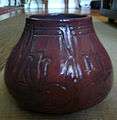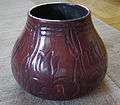Newcomb Pottery
| Newcomb College Pottery | |
|---|---|
 Brochure advertising Newcomb College Pottery, early 1900s | |
| Movement | Arts & Crafts |
| Website | http://www.tulane.edu/~wc/pottery/menu.html |
Newcomb Pottery, also called Newcomb College Pottery, was a brand of American Arts & Crafts pottery produced from 1895 to 1940.[1] The company grew out of the pottery program at H. Sophie Newcomb Memorial College, the women's college now associated with Tulane University in New Orleans, Louisiana. The Pottery was a contemporary of Rookwood Pottery, the Saturday Evening Girls, North Dakota pottery, Teco and Grueby.
The program
Newcomb College had been founded expressly to instruct young Southern women in liberal arts.[2] The art school opened in 1886 and production of art pottery on a for-profit basis began in 1895 under the supervision of art professors William Woodward, Ellsworth Woodward, and Mary Given Sheerer.[3][4][5]
Potters
Among the first persons to be hired by the Woodwards to assist with the new pottery program were the potters. Unlike the artists who created and carved the designs for the Pottery, the potters were all men, as it was believed that a "male potter would be needed to work the clay, throw the pots, fire the kiln and handle the glazing."[6] The first potter hired was Jules Garby in 1895. He was followed by one of Newcomb Pottery's most recognized potters, Joseph Meyer, in 1896. Notably, George Ohr was hired as a potter at approximately the same time as Joseph Meyer, but Ohr left Newcomb to work on his own sometime in 1897.[6] Meyer's cipher is found on more pieces of Newcomb College Pottery than any other person.[6] Meyer won awards for his work at Newcomb at the Pan-American Exposition in Buffalo and the 1904 Louisiana Purchase Centennial Exposition.[6] Meyer stayed with the Pottery until his retirement in 1927. He was replaced by Jonathan Hunt in 1927 and later Kenneth Smith in 1929. After Hunt left the Pottery in 1933, he was replaced by Francis Ford. Both Smith and Ford stayed with the Newcomb Pottery program through its termination in 1940.[6]
Craftsmen
When the Pottery was first established, any woman who studied art at Newcomb College was allowed to sell wares that she had decorated, provided it was judged to be adequate for sale by the faculty at the school.[6] Over the years, the Pottery employed dozens of women.
Some early Newcomb College artists included:[6]
- Sadie Irvine
- Harriet Joor
- Selina Bres
- Marie and Emilie De Hoa LeBlanc
- Cynthia Littlejohn
- Mazie T. Ryan
- Sarah (Sallie) Henderson
- Henrietta Bailey
- Frances Lawrence Howe Cocke
- Roberta Kennon
- Sara B. Levy
- Ada Lonnegan
- Mary Given Sheerer
- Leona Nicholson
- Amelie and Desiree Roman
Eventually the women who worked regularly with the Pottery were designated as craftsmen with a preference given to those who had completed an undergraduate degree and a later graduate studies program with the art department.[6]
As the Pottery grew and expanded, new craftsmen joined the program including:[6]
- Anna Frances Simpson
- Aurelia Arbo
- Juanita Gonzales
- Corinne Chalaron
- Lucia Arena
While the craftsmen did not typically pot their own pieces, they were responsible for creating and carving designs for each piece of pottery the program put out. During the lifespan of the Pottery, over 70,000 unique pieces were created and carved by the women.[7]
The Pottery
Early pieces at the Pottery closely reflected the arts and crafts era in which the Pottery was operating. The pottery often depicted Louisiana's local flora, done in blue, yellow and green high glazes. The high point of Newcomb is generally considered to be from 1897 to 1917. During that period the Pottery experimented with various glazes and designs, and won numerous awards at various exhibitions throughout the country and in Europe. As the school entered the 1920s, new professors arrived and began to introduce influences from the 1913 International Exhibition of Modern Art. Highly carved pieces done in matt glazes of blue, green and pink marked this period. Perhaps one of the most famous Newcomb Pottery designs, the "Moon & Moss" style was introduced in this period.

How to identify Newcomb College Pottery
The Pottery used an elaborate system of marks to indicate a piece came from Newcomb College.[6]
Newcomb College, potter and craftsman marks
The marks would include an "N" inside of a "C" to indicate the school, along with the ciphers of the potter and craftsman who both created the piece.[6]
Registration numbers
Also typically included would be a registration number indicating the year the piece was made.[6] The registration number for a Newcomb piece consisted of a letter or combination of letters to indicate the year the piece was made, along with a number from 1-100.[6] While most Newcomb pieces do have a registration number, some pieces, particularly earlier ones that were glazed but not otherwise decorated, do not.
Marks indicating clay and glaze used
In addition to the marks already mentioned, pieces prior to 1915 sometimes also had marks indicating the type of clay and glaze used for the piece.[6]
These marks include:
| Mark | Clay and glaze used | Years used |
|---|---|---|
| U | White clay | 1895–1902 |
| W | White clay | 1895–1908 |
| Q | Buff clay | 1895–1909 |
| R | Dark red clay | 1895–1910 |
| F | Dark red clay body with opaque glaze | 1895–1907 |
| FR | Dark red clay body with red glaze | 1895–1907 |
| B or B (enclosed in a circle) | Buff clay with a semi-matte glaze | 1910–1912 |
| C or C (enclosed in a circle) | Buff clay with a semi-matte glaze | 1913–1915 |
| A, D, E, F, G, K or T | White clay with a glass glaze | |
Newcomb Guild and the end of Newcomb Pottery
As tastes changed, and Arts & Crafts-style pottery became less popular and profitable for the College, the Pottery ceased production in 1940. It was replaced by the Newcomb Guild program that focused more on utilitarian wares, rather than the decorative pottery which symbolized the earlier Newcomb era.[6] Members of the earlier pottery program including Kenneth Smith, Francis Ford and Sadie Irvine continued producing pieces with the Newcomb Guild. However, the Newcomb Guild proved to be less popular than the earlier program and it effectively ended with Sadie Irvine's retirement in 1952.[6]
Smithsonian Institution Exhibition
The Smithsonian Institution put forward a traveling exhibition of Newcomb College Pottery that ran from October 2013 to October 2016. The exhibition visited various cities around the United States, and displayed approximately 180 objects from the Newcomb College Pottery program, along with metalwork, jewelry, textiles and other objects made during the period the Pottery was in operation.[8]
Examples of Newcomb College Pottery
 Group of Newcomb College Pottery pieces showing a variety of forms
Group of Newcomb College Pottery pieces showing a variety of forms Various undecorated Newcomb College Pottery pieces showing a variety of forms
Various undecorated Newcomb College Pottery pieces showing a variety of forms Newcomb College Pottery plate potted by Joseph Meyer and decorated by Mazie T. Ryan from 1905
Newcomb College Pottery plate potted by Joseph Meyer and decorated by Mazie T. Ryan from 1905 Example of Newcomb College Pottery marks from the Ryan Plate
Example of Newcomb College Pottery marks from the Ryan Plate Newcomb College Pottery vase potted by Joseph Meyer and decorated by Sara Levy from 1905
Newcomb College Pottery vase potted by Joseph Meyer and decorated by Sara Levy from 1905 Another View of Newcomb College Pottery vase potted by Joseph Meyer and decorated by Sara Levy from 1905
Another View of Newcomb College Pottery vase potted by Joseph Meyer and decorated by Sara Levy from 1905 Example of Newcomb College Pottery marks from the Levy vase
Example of Newcomb College Pottery marks from the Levy vase A pot by Joseph Meyer, made between 1911 and 1925
A pot by Joseph Meyer, made between 1911 and 1925 Newcomb College Pottery vase in the "Moon & Moss" style, potted by Francis Ford and decorated by Aurelia Arbo sometime in the 1930s
Newcomb College Pottery vase in the "Moon & Moss" style, potted by Francis Ford and decorated by Aurelia Arbo sometime in the 1930s Rear of the Arbo vase in the "Moon & Moss" style with carved oak trees.
Rear of the Arbo vase in the "Moon & Moss" style with carved oak trees. Newcomb College Pottery vase potted and glazed by Joseph Meyer
Newcomb College Pottery vase potted and glazed by Joseph Meyer Example of Newcomb College Pottery marks from Meyer vase. This vase has no registration number, but dates from 1895-1907 due to the "FR" marking.
Example of Newcomb College Pottery marks from Meyer vase. This vase has no registration number, but dates from 1895-1907 due to the "FR" marking. Examples of Newcomb College Pottery from Smithsonian Traveling Exhibition showing a rare copper red reduction glaze
Examples of Newcomb College Pottery from Smithsonian Traveling Exhibition showing a rare copper red reduction glaze Examples of Newcomb College Pottery from Smithsonian Traveling Exhibition with a cactus flower decoration
Examples of Newcomb College Pottery from Smithsonian Traveling Exhibition with a cactus flower decoration Example of Newcomb College Pottery from Smithsonian Traveling Exhibition showing repeating long stemmed flowers
Example of Newcomb College Pottery from Smithsonian Traveling Exhibition showing repeating long stemmed flowers Examples of Newcomb College Pottery from Smithsonian Traveling Exhibition showing art deco decoration
Examples of Newcomb College Pottery from Smithsonian Traveling Exhibition showing art deco decoration Example of Newcomb College Pottery from Smithsonian Traveling Exhibition with a repeating "red" cedar tree decoration
Example of Newcomb College Pottery from Smithsonian Traveling Exhibition with a repeating "red" cedar tree decoration Example of Newcomb College Pottery from Smithsonian Traveling Exhibition with a repeating blue crab decoration
Example of Newcomb College Pottery from Smithsonian Traveling Exhibition with a repeating blue crab decoration
References
- ↑ Poesch, Jessie J. & Spanola, Sally M. (1984). Newcomb Pottery: An Enterprise for Southern Women, 1895-1940.
- ↑ Newcomb Pottery: Its Makers and the Lessons They Are Teaching Southern Women. The Sunset, Vol.11. 1903.
- ↑ Lowe, John (2005). Bridging southern cultures: an interdisciplinary approach. pp. 133–153.
- ↑ Cullison, William R. (1984). Two Southern Impressionists: An Exhibition of the Work of the Woodward Brothers, William and Ellsworth.
- ↑ admin. "Women, Art and Social Change: The Newcomb Pottery Enterprise".
- 1 2 3 4 5 6 7 8 9 10 11 12 13 14 15 16 Poesch, Jessie & Main, Sally (2003). Newcomb Pottery and Crafts: An Educational Enterprise for Women.
- ↑ Dalide, Monica (2008). 683 Things About New Orleans. pp. 147–148.
- ↑ "Smithsonian Institution Traveling Exhibition Service - Women, Art, and Social Change: The Newcomb Pottery Enterprise".
External links
- Finding aid to the Newcomb College Art Department Collection on Newcomb Pottery, Newcomb Archives and Vorhoff Library Special Collections, Tulane University
- Finding aid to the Newcomb Pottery Records, Newcomb Archives and Vorhoff Library Special Collections, Tulane University
- Finding aid to the Newcomb Pottery Research Records, Newcomb Archives and Vorhoff Library Special Collections, Tulane University